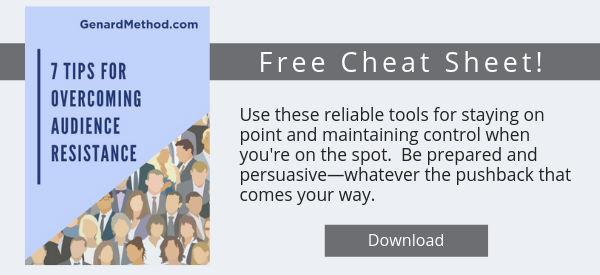Is your organization looking to improve its presentation skills? If the answer is yes, that's no surprise: virtually everyone can benefit from presenting their service, product, or personnel in the best possible light.
But how do you go about assessing your needs? Is there a particular style of training suitable for your industry? Do your people have unique learning requirements or preferences? Should a workshop be based primarily on delivery skills or content? Should you include a segment on speaking anxiety? (To get your presenters as relaxed and focused as possible, download our cheat sheet, "How to Calm Your Nerves Before Speaking.")
This article offers a quick guide concerning how to assess your internal needs for training. Here are 5 important points to keep in mind.
1. Where you're located doesn't matter. It's natural to think first of looking around in your local market. But even if you conduct business strictly locally, you needn't limit yourself to the small pool of experts that exist in your vicinity. The principles of dynamic, influential communication are the same across industries and disciplines. Don't just splash around in the local swimming hole—sail out into the great ocean of expertise and find the very best that's out there.
2. Think of your purpose first and your content second. Again, a natural inclination is to land on the foundation of your typical content and believe this is also where you need to seek subject expertise. Actually, the opposite is true: you and your employees already have content coming out of your ears. You need to stay focused on the reason you give presentations in the first place. It's your stakeholders that matter in your presentations, not you (and even the data you present are secondary). Information is always used to the purpose of influencing audiences. Learn how to conduct an audience analysis. Given their requirements and expectations, what help do you need to succeed with them?
3. Review the personalities involved. Your employees have strengths and weaknesses as individuals that should help you in finding the right training. No work force is all one way or the other: "We're in life sciences, so all our people are shy and hate speaking in public." The smaller the team, the bigger role personalities will play in the training equation. Young employees often need help with credibility; while senior leaders may benefit from training to make them more accessible, and so on. Your presenters need to know the ways to become a more charismatic speaker, so help them do so more easily.
4. Consider your organization's culture. Recently, I conducted a two-day workshop on presentation skills at a large bank. The organization wanted help in particular with executive presence, and as a former actor I planned exercises using improvisation and role-playing. During the first morning, a participant casually mentioned how they'd previously brought in a trainer who was "all touchy-feely and it didn't go over well at all." I was certainly thankful for that offhand remark, as I immediately scrubbed those activities! What will go down well with your people? Seminar? Discussion? Hands-on workshop? Webinar?
5. Break down your budget into cost per employee. First-class training that will transform your organization's ability to impact stakeholders is expensive. It is, of course, an investment well worth making. Before you get scared by the potential price tag, instead of the unit cost calculate the cost per employee. Ten thousand dollars for a day of sales presentation training may seem high, but for the 50 sales people who will be participating, that works out to a miniscule $200 per person. And considering the ten million dollars in revenue that the Sales department generated last year . . . .
The needs of your employees are as important as the needs of your stakeholders. Identifying the outcomes you're looking for to strengthen your internal and external communications is worth careful time and attention to your actual versus your perceived requirements. The more specifically you can identify your organization's needs, the more successful you will be in meeting those needs. It's the same dynamic that exists in meeting the expectations of your customers, clients, and constitutents.
Key takeaways from this blog:
- Every organization can benefit from stronger presentation skills.
- Assess your particular needs as well as training firms.
- Be guided by your purpose, and consider culture and personalities.



